by Dagmara Genda, studio photos by Ryan Molnar // Apr. 14, 2023
When, during our studio visit, Nadine Fecht asks “how can we co-exist together?” she speaks to the tension between the multitude and the individual, an internal perspective as opposed to the one projected from the outside. It’s the same question that guided ruangrupa in their curation of documenta fifteen last year but, in Fecht’s work, it is not a practical problem to be solved as much as an existential state with which one grapples. This is why she uses it as a formal device. With its combination of writing, large format drawings and what can only be described as rote, exhaustive labour, Fecht’s work embodies the struggle of situating oneself between intersecting definitions, mainly between socio-political and personal ones. On an aesthetic and philosophical level, she explores the boundaries of the individual, their responsibilities and the possibility of dissolving into a larger, unwieldy whole.
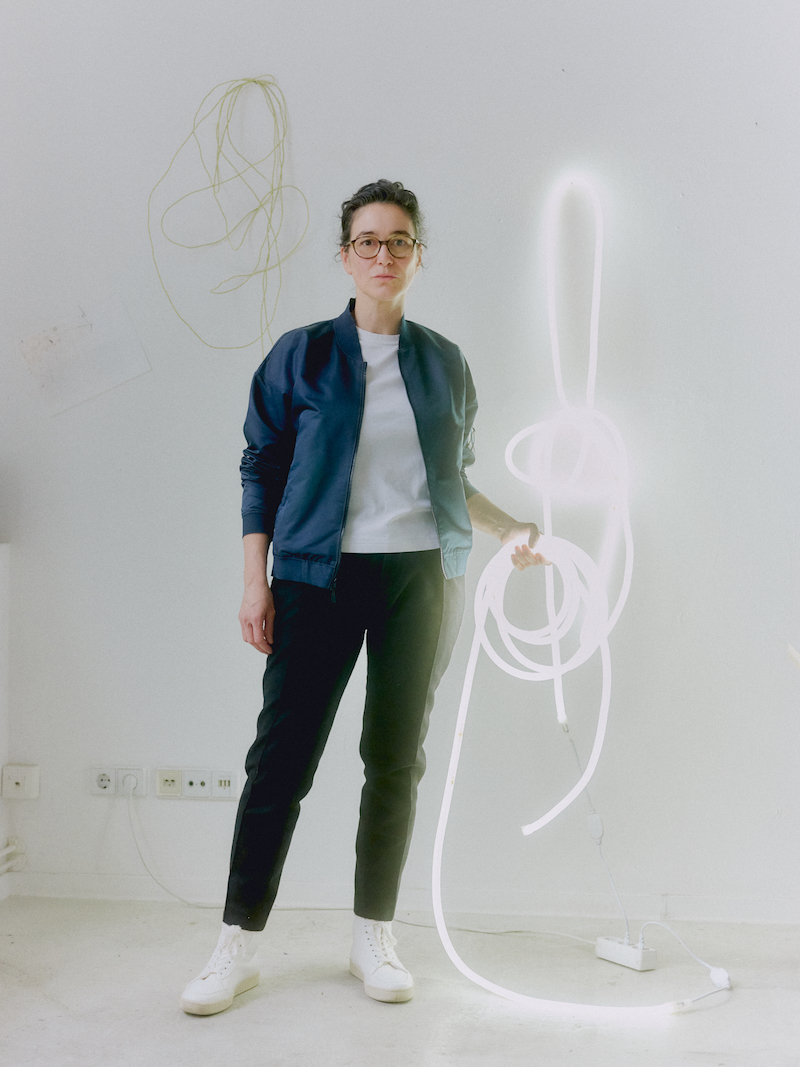
What Fecht has called a “Nichtzurruhekommen”—that is, an expectant state of nebulous tension—reverberates through the room. It is caused by the sound of burning fuses that the artist plays quietly, as a sort of softly hissing soundtrack to our studio visit. In a process evocative of Cai Guo Qiang, the artist lit different types of fuses, some slow burning and others explosively crackling, on pieces of paper to create large-scale drawings from burn marks and ash. Over two meter tall filigree drawings from the in-process series ‘Multitude (Die Vielen als Viele)’ hang on the wall. They are made with ballpoint pen, or more exactly, about 2400 multi-coloured ballpoint pens that have been assembled on and dragged across the paper to create a staticky cloud of scratchy marks. The lines, reminiscent of the wear and tear of a well-used surface—maybe a cutting board or a very old table—are a visual reflection of the seething video documentation in the background. Together with the sound, they give an anxious edge to this otherwise silent, grey Saturday morning.

Outside the artist’s studio window flows the Spree, with red construction cranes perched in the construction site on the other side. “They have been there since I moved in 13 years ago,” says Fecht. Behind them stands a near impenetrable wall of mass-produced apartment blocks with small, deeply set, square windows. Their pastel yellow, beige and purple facades, perhaps intended to add a splash of freshness to their repetitive, blocky architecture, effortlessly blend into the monotone of the Berlin sky. On the concrete bank of the river someone has written “ICH LIEBE DICH” in huge, white, block letters. Fecht usually closes the blinds when she works: “The view is too romantic.”
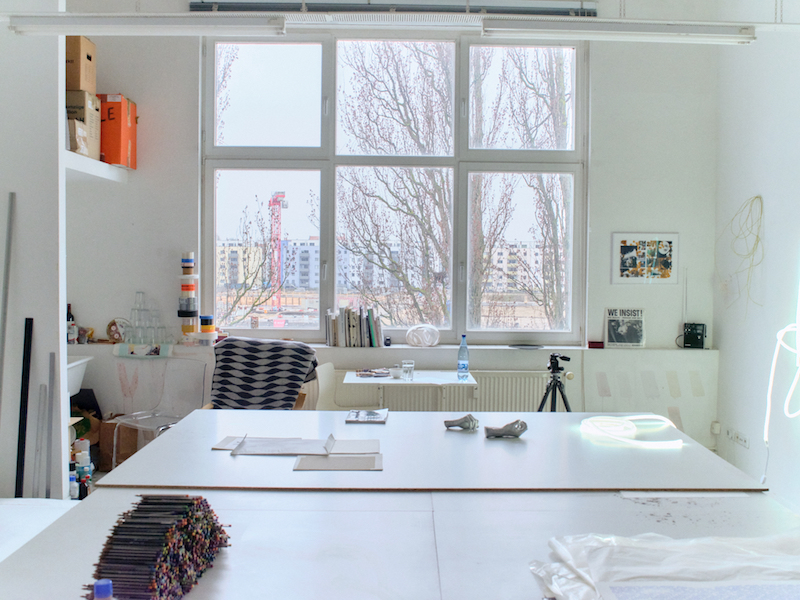
This typical east Bloc melancholia, for which Berlin has become known and perhaps somewhat fetishised, is, like everything else in the city, becoming gentrified. The new airport, which took a grand total of 14 years to build, is slowly changing this remote and, until recently, undesirable part of the city. The neighbouring Hochschule für Technik and Wirtschaft will be expanding their student accommodations by building on the parking lot between the yellow brick warehouses that have housed artist studios for many years. The warehouses themselves will become commercial spaces or perhaps luxury lofts. The story repeats itself with exhausting frequency in this city. How do we co-exist together when the city is bent on lucrative expansion? Who gets squeezed out of the increasingly narrow vision of a colourful, privately owned future?
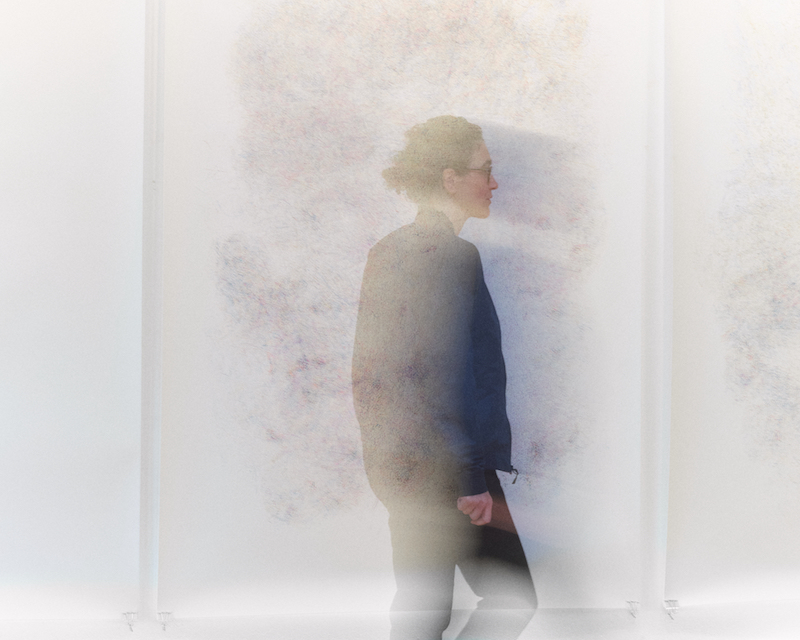
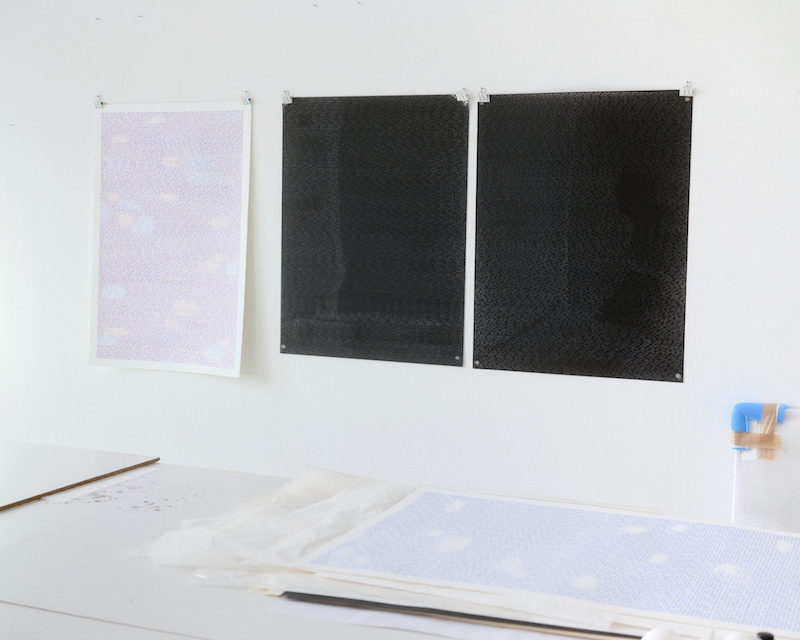
Class inflects Fecht’s practice, weaves its way through the material and content, but does not necessarily form the raison d’être for the work. Her practice consists predominantly of drawing, which can start out as an intuitive exploration of materials that accretes with meaning over the years. The relationship between form and content, notes Fecht, is one of mutual sustainability—both reinforce each other in a relationship that is as much material as metaphorical. Fire is used in a series of work entitled ‘EIGENTUM’ (2020-) (meaning property, ownership or more generally, assets) both as a warning and a threat. The first part of ‘Social Fabric’—a 120 x 85 cm screen print consisting of three layers—is displayed on one wall. The image overlays the respectively blue, (Ferrari) red and white words—SUBALTERNE, ELITE and BOURGEOISIE—atop each other in layers. It is planned as a pattern to be repeated on fabric and stretched across a wall. Both pieces are punctured by holes—visual openings in the layers of ‘Social Fabric’ and literal openings in the paper burned through with fire. “The gap,” says Fecht, “is where the potential for change lies.”
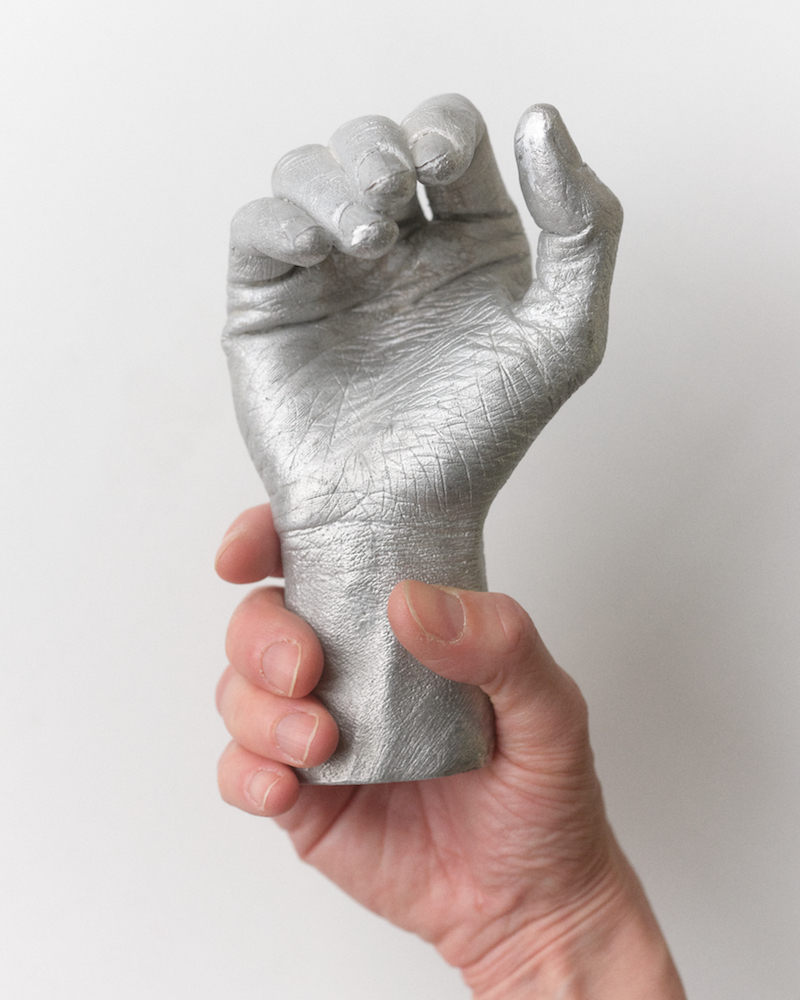
Since 2015, the artist has been making text-based pieces, wherein the text not only serves to illuminate a topic but becomes a medium in its own right. The many thousand time repetition of “I AM NOT HYSTERICAL” creates a glitchy, shifting pattern on each of the five 2 x 1.35 m large sheets of paper. The adamant statement is a denial but its obsessive repetition is also an admission. In what is a graphic take on the Freudian talking cure, the artist “wanted to write myself out of the projected identities that society imposes.” This restless desire to escape is present in many of her works but, even though they are often punctured with holes, their ominous size and repetitive forms cut off the possibility of an exit. Interestingly, it is precisely ‘the exit series’ (2013) that has no such holes. The 100 x 70 cm works are a precursor to the current over 2-meter-tall pieces. They were made with 1200 black ballpoint pens and the occasional paper refuse, consisting of small bits of packaging and price stickers. The artist admits that in reality there is no escape though, through the works, she intends to provide a glimpse into a constant state of incompletion.
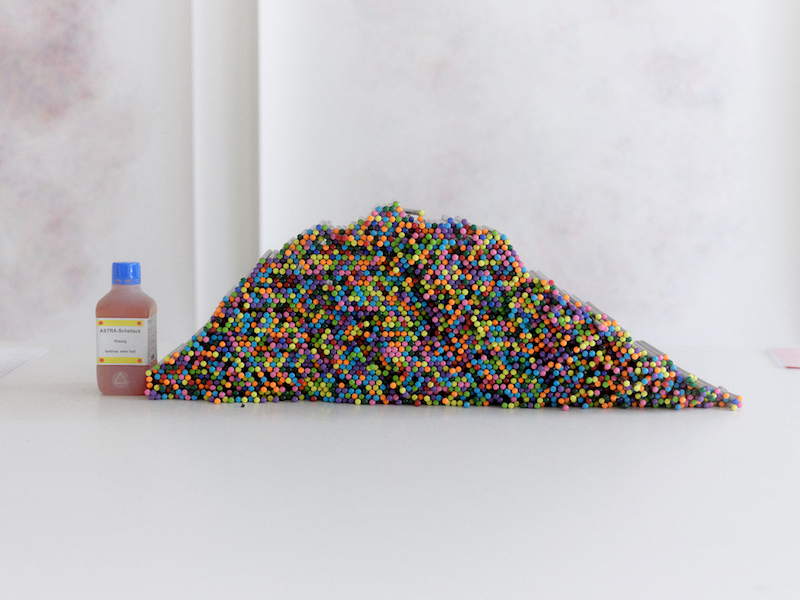
Fecht says I am not the first one to associate her Sisyphean labour with a type of punishment—a more brooding version of John Baldessari’s “I will not make more boring art.” The clinically-lit rooms and monotone drone of white noise, both visual and sometimes auditory, reflect an urban alienation, a dulled indifference induced by the real difference of individuals subsumed by masses of people. I insist Fecht’s work is inescapably psychological. The viewer cannot help but relate to or cringe before the expenditure of energy and time. Fecht disagrees. The block letters, she tells me, are a distancing mechanism and the repetition is far from punishment, nor is it, as I also mused, a type of meditation. The artist is speaking to structural phenomena, in which she attempts to find herself and from which she might potentially free herself. This is why she insists on making the work herself, despite the fact that her programmatic approach could be reproduced by a group of assistants. After each marathon work, she says she comes out the other side a different person.
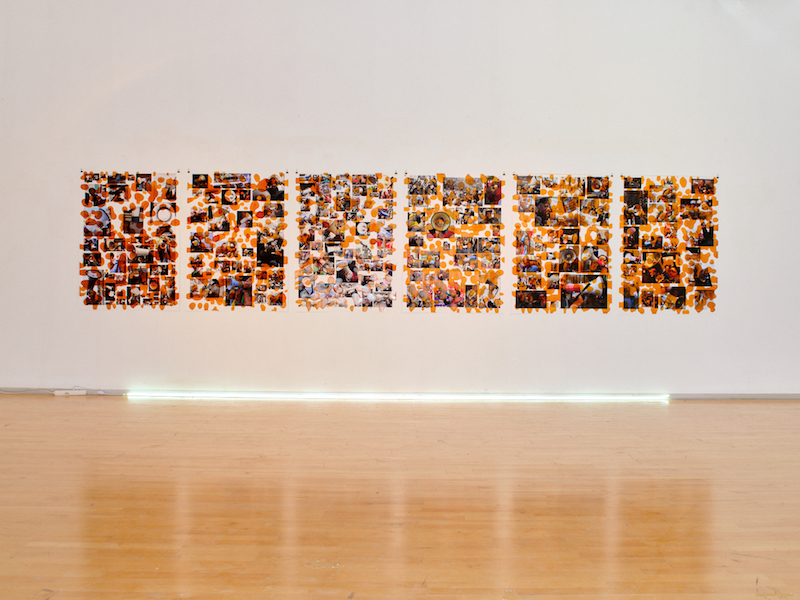
Our disagreement over the reading of her work echoes the process through which it is made. With ‘Multitude (Die Vielen als Viele),’ she explains, the mass of bound pens could not be moved by herself alone, and so she enlisted the help of an assistant to drag the bundle over the expansive sheet of paper. The topic of co-existence became actualised in the act itself. In their negotiation of how to move the pens, Fecht and her drawing partner started to argue. The works are thus traces of two types of struggle—the difficulty presented by the mass of pens as well as the negotiation of another human being.
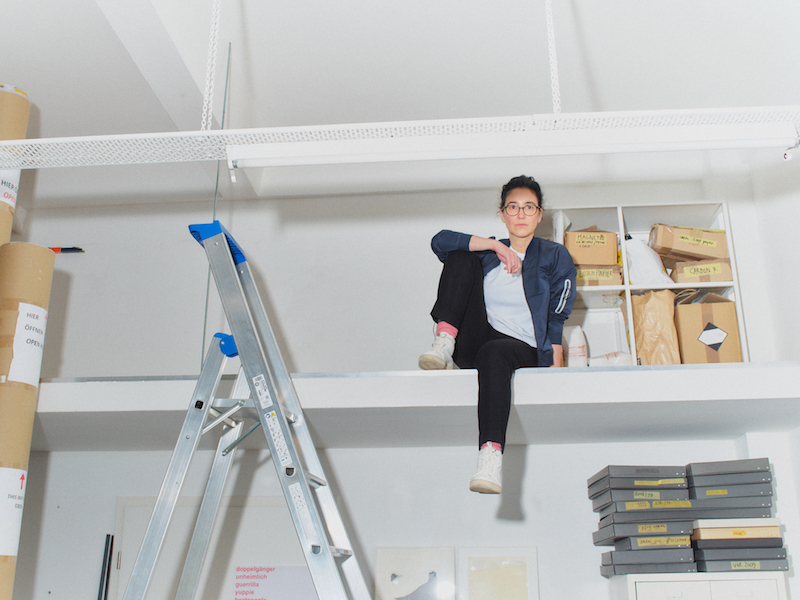
“Hell is other people,” is the famous quote from Jean-Paul Sartre’s ‘No Exit,’ a 1944 theatre piece about three people doomed to stay for all eternity in a room together. The play is ultimately about how one is seen by other people, and the need to somehow situate oneself within a complex of projection, censure and judgment. More fundamentally one might ask what an individual even is or where their boundaries lie within this complex. Sartre argued that a person has the freedom to change and thus made a case for personal responsibility—a sentiment perhaps most embodied by Fecht’s work ‘privileged’ (2016), wherein the words “BEING WHITE” were repeatedly written in white ink, using two different types of pens, on over 108 sheets of A4 carbon paper. Later shown in a diptych—the black sheets with white text on one 278 x 278 cm square, and the grey words on the white—the piece speaks to how one deals with one’s own skin colour, which is, on the one hand, a biological fact, and on the other, a projected socio-political identity. In her repetition of the phrase, which ends up alternating “BEING WHITE” with “WHITE BEING,” Fecht doesn’t so much write herself out of this particular complex of signifiers, but searches for difference in the variations of the same. In Fecht’s case, an exit might not be an escape, which is ultimately impossible, but a diving into. Instead of drawing the contours of identity, of attempting to gain an overview, Fecht loses herself in the details—and via scale attempts to pull the viewer in as well—so as to find the glitch, the gap, or the break that might catalyse something new.
Artist Info
Exhibition Info
Hamburger Bahnhof
Group Show: ‘Broken Music Vol. 2: 70 Years of Records and Sound Works by Artists’
Exhibition: Dec. 17, 2022 – May 14, 2023
smb.museum/en/exhibitions/detail/broken-music-vol-2
Invalidenstraße 50-51, 10557 Berlin, click here for map
Kupferstichkabinett
Group Show: ‘World Framed’
Exhibition: Jul. 7 – Oct. 8, 2023
smb.museum/museen-einrichtungen/kupferstichkabinett/
Matthäikirchplatz, 10785 Berlin, click here for map






















